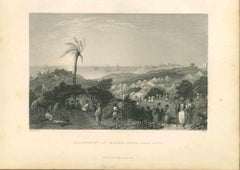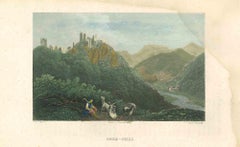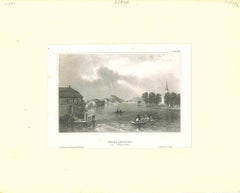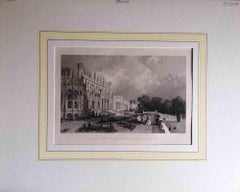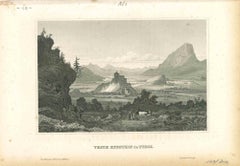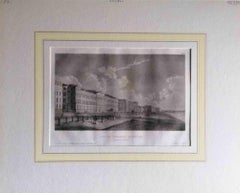Mid-19th Century Landscape Prints
to
22
708
201
29
17
2
Overall Width
to
Overall Height
to
509
19
11
5
3
1
88
48
34
22
18
1,016
2,086
9,946
4,100
117
117
689
517
591
1,113
1,480
1,729
1,296
599
657
701
255
1
580
203
180
125
121
92
91
80
78
73
62
61
52
51
49
48
44
41
39
34
642
189
118
103
55
66
700
401
262
Period: Mid-19th Century
The Encampment of Ibrahim Pasha - Original Lithograph Mid-19th Century
Located in Roma, IT
The Encampment of Ibrahim Pasha is an original modern artwork realized in the mid-19th Century.
Original B/W Lithograph on Ivory Paper.
Inscripted on the lower margin in Capital ...
Category
Mid-19th Century Landscape Prints
Materials
Paper, Lithograph
Ober - Cilli - Original Lithograph on Paper - Mid-19th Century
Located in Roma, IT
Ober - Cilli is an original modern artwork realized in the first half of the 19th Century.
Original Colored Lithograph on Ivory Paper.
Inscripted on the lower margin in Capital L...
Category
Modern Mid-19th Century Landscape Prints
Materials
Lithograph
Ancient View of Eskilstuna - Original Lithograph - Mid-19th Century
Located in Roma, IT
Ancient View of Eskilstuna is an original modern artwork realized in Germany in the Mid-19th Century.
Original B/W Lithograph on Ivory Paper.
Inscripted on the lower central margi...
Category
Modern Mid-19th Century Landscape Prints
Materials
Lithograph
Ancient View of Eaton Hall - Original Lithograph - Mid-19th Century
Located in Roma, IT
Eaton Hall is an original modern artwork realized in the Mid-19th Century.
Original B/W Lithograph on Ivory Paper.
Inscripted on the lower central margin...
Category
Modern Mid-19th Century Landscape Prints
Materials
Lithograph
Veste Kufstein - Original Lithograph on Paper - Mid-19th Century
Located in Roma, IT
Veste Kufstein is an original modern artwork realized in the first half of the 19th Century.
Original B/W Lithograph on Ivory Paper.
Inscripted on the lower margin in Capital Let...
Category
Modern Mid-19th Century Landscape Prints
Materials
Lithograph
Grand Terrace, Brighton - Original Lithograph - Mid-19th Century
Located in Roma, IT
Grand Terrace, Brighton is an original modern artwork realized in the Mid-19th Century.
Original B/W Lithograph on Ivory Paper.
Inscripted on the lower central margin in Capital L...
Category
Modern Mid-19th Century Landscape Prints
Materials
Lithograph
Sheffield - Original Lithograph - Mid-19th Century
Located in Roma, IT
Sheffield is an original modern artwork realized in the Mid-19th Century.
Original B/W Lithograph on Ivory Paper.
Inscripted on the lower central margin in Capital Letters: Sheffi...
Category
Modern Mid-19th Century Landscape Prints
Materials
Lithograph
Ancient View of Cyprus - Original Lithograph - Mid-19th Century
Located in Roma, IT
Cyprus is an original modern artwork realized in the mid-19th Century.
Original B/W Lithograph on Ivory Paper.
Inscripted on the lower margin in Capital Letters: Cyprus Hauptstad...
Category
Modern Mid-19th Century Landscape Prints
Materials
Lithograph
Ancient View of The Ruins of Philae - Original Lithograph - Mid-19th Century
Located in Roma, IT
The Ruins of Philae is an original modern artwork realized in the mid-19th Century.
Original B/W Lithograph on Ivory Paper.
Inscripted on the lower margin in Capital Letters: Die...
Category
Mid-19th Century Landscape Prints
Materials
Paper, Lithograph
Heriot's Hospital - Original Lithograph - Mid-19th Century
Located in Roma, IT
Heriot's Hospital is an original modern artwork realized in the Mid-19th Century.
Original B/W Lithograph on Ivory Paper.
Inscripted on the lower central margin in Capital Letters...
Category
Modern Mid-19th Century Landscape Prints
Materials
Lithograph
Pembroke Castle - Original Lithograph - Mid 19th Century
Located in Roma, IT
Pembroke Castle is an original modern artwork realized in Germany in the Early 19th Century.
Original B/W Lithograph on Ivory Paper.
Inscripted on the lower central margin in Capi...
Category
Modern Mid-19th Century Landscape Prints
Materials
Lithograph
Ancient View of Sultan Selims Moschee in Costantinople - Lithograph - 1850s
Located in Roma, IT
Ancient View of Sultan Selims Moschee in Costantinople is an original modern artwork realized in the first half of the 19th Century.
Original Black and W...
Category
Old Masters Mid-19th Century Landscape Prints
Materials
Lithograph
Montblanc - Original Lithograph - Mid-19th Century
Located in Roma, IT
Montblanc is an original modern artwork realized in the Mid-19th Century.
Original B/W Lithograph on Ivory Paper.
Inscripted on the lower central margin in Capital Letters: Montbl...
Category
Modern Mid-19th Century Landscape Prints
Materials
Lithograph
Fonte Canapina - Original Etching by Luigi Bartolini - 1940
Located in Roma, IT
Image dimensions: 12.5 x 19.5 cm.
Fonte Canapina (Canapina Fount) is an original work realized by Luigi Bartolini in 1940.
Original etching on China paper applied.
Hand-signed in ...
Category
Mid-19th Century Landscape Prints
Materials
Etching
Ancient View of Strasburg - Original Lithograph - Mid-19th Century
Located in Roma, IT
Ancient View of Strasburg is an original modern artwork realized in the Mid-19th Century.
Original B/W Lithograph on Ivory Paper.
Inscripted on the lower central margin: Strasburg...
Category
Modern Mid-19th Century Landscape Prints
Materials
Lithograph
Ancient View of Schloss Kurburg - Original Lithograph - Mid-19th Century
Located in Roma, IT
Ancient View of Schloss Kurburg is an original modern artwork realized in the mid-19th Century.
Original B/W Lithograph on Ivory Paper.
Inscripted on the lower margin in Capital ...
Category
Modern Mid-19th Century Landscape Prints
Materials
Lithograph
Pilgrims at the Sacred Fair of Hurdwar - Original Lithograph- Mid 19th century
Located in Roma, IT
Pilgrims at the Sacred Fair of Hurdwar is an original modern artwork realized in the Mid-19th Century.
Original B/W Lithograph on Ivory Paper.
Inscripted on the lower margin: Pilg...
Category
Modern Mid-19th Century Landscape Prints
Materials
Lithograph
The Head - Original Woodcut by Giorgio Wenter Marini - 1925
Located in Roma, IT
The Head is an original Woodcut from ""quaderni dell'Eroica", realized by Giorgio Wenter Marini in 1925.
Good conditions.
The artwork is depict...
Category
Modern Mid-19th Century Landscape Prints
Materials
Woodcut
La Roxerie - Original Etching by Sir Francis Seymour Haden - 1867
Located in Roma, IT
La Roxerie is an original modern artwork realized by the English artist Sir Francis Seymour Haden (1818 – 1910) in 1867.
Original Etching on paper.
Signed and dated on plate on th...
Category
Modern Mid-19th Century Landscape Prints
Materials
Etching
Trees - Original Etching on Paper - Early 20th Century
Located in Roma, IT
Trees is an original etching on paper, realized by an Anonymous artist of the early XX century.
Hand-signed on the lower in pencil and numbered, illegible, with the dedication.
The...
Category
Mid-19th Century Landscape Prints
Materials
Etching
The Return - Lithograph - Mid 19th Century
Located in Roma, IT
Sleeping Dog is an original drawing on paper, realized by an Anonymous artist of the XIX century. There is The state of preservation of the artwork is ver...
Category
Mid-19th Century Landscape Prints
Materials
Lithograph
Stargard - Original Lithograph Mid 19° Century
Located in Roma, IT
Stargard is a beautiful color lithograph on paper, printed by von Led Kempner and published by von Schaffstein and C. Koln, Rhein.
This modern artwork representing a view of the Po...
Category
Mid-19th Century Landscape Prints
Materials
Lithograph
Interieur de Geneve. Fontaine de Beauregard-Original Lithograph by A. Fontanesi
Located in Roma, IT
Image dimensions: 15.7 x 22.3 cm.
This splendid lithograph Interieur de Geneve. Fontaine de Beauregard is part of the series of 20 prints dedicated to views of the city of Geneva, e...
Category
Mid-19th Century Landscape Prints
Materials
Lithograph
View of Taranto - Etching by Achille Parboni - 1843
Located in Roma, IT
Image dimensions: 11.5 x 14.7 cm
Vie of Taranto is an original black and white etching on paper, realized by the Italian engraver Achille Parboni.
Printed as a plate of the prints ...
Category
Modern Mid-19th Century Landscape Prints
Materials
Etching
Interieur de Geneve. Rue de l'Hotel de Ville - Lithograph by A. Fontanesi - 1854
Located in Roma, IT
This splendid lithograph Rue de l'hotel de Ville is part of the series of 20 prints dedicated to views of the city of Geneva, engraved by the Italian artist Antonio Fontanesi in 1854...
Category
Naturalistic Mid-19th Century Landscape Prints
Materials
Lithograph
View of Oran - Original Lithograph - 1846
Located in Roma, IT
View of Oran is an original Hand-colored lithograph on paper realized in 1846 by an Anonymous artist of the XIX century.
Titled in Italian on the lower center "Oran".
The state of...
Category
Old Masters Mid-19th Century Landscape Prints
Materials
Lithograph
The Living Kit - Woodblock Print after Utagawa Kunisada - Late 19th Century
Located in Roma, IT
The Living Kite is an original Woodcut print realized in the late 19th century after Utagawa Kunisada.
Good condition except for some damaged paper on the edge and Beautiful colore...
Category
Modern Mid-19th Century Landscape Prints
Materials
Woodcut
View of Sepino - Original Lithograph by F- Cirelli - Mid 19th Century
Located in Roma, IT
Veduta di Sepino is an original artwork realized in the XIX Century by Cirelli.
Colored Lithograph on paper.
On the lower left corner the writing "P. Mattei di dal vero" and, on ...
Category
Old Masters Mid-19th Century Landscape Prints
Materials
Lithograph
Ancient View of Monte Pellegrino - Lithograph on Paper - Mid-19th Century
Located in Roma, IT
Ancient View of Monte Pellegrino is an original modern artwork realized in Italy in the first half of the 19th Century.
Original Lithograph on Ivory Paper.
Inscripted on the lowe...
Category
Mid-19th Century Landscape Prints
Materials
Lithograph
Ancient Vied of the Dome of Milan - Original Lithograph - Mid-19th Century
Located in Roma, IT
Milan Cathedral is an original modern artwork realized in Italy in the first half of the 19th Century.
Original Lithograph on Ivory Paper.
Inscripted on the lower margin: Milan C...
Category
Modern Mid-19th Century Landscape Prints
Materials
Lithograph
Port de la Nouvelle-Orléans - Original Woodcut by A.-F. Pannemaker - 1865
Located in Roma, IT
Port de la Nouvelle-Orléans s a beautiful black and white xylograph on paper, realized by François Pannemaker, after a drawing from a photograph by E. de Berard, as the caption under the image suggests and the signature under the print on sides " E. de Berard / Pannemaker=Ligny".
Realized in 1865, this original print offers us a wonderful and historical view on the lively New Orleans port...
Category
Modern Mid-19th Century Landscape Prints
Materials
Woodcut
Ancient View of Terni - Original Lithograph - Mid 19th Century
Located in Roma, IT
Terni is an original modern artwork realized in the Mid-19th Century.
Original B/W Lithograph on Ivory Paper.
Inscripted on the lowet margin: Terni. Engraved by A.H. Payne.
Tota...
Category
Modern Mid-19th Century Landscape Prints
Materials
Lithograph
The Eskimos - Original Lithograph by Paul Gervais - 1854
By Paul Gervais
Located in Roma, IT
The Eskimos is an original lithograph on ivory-colored paper, realized by Paul Gervais (1816-1879). The artwork is from The Series of "Les Trois Règnes de la Nature", and was publish...
Category
Modern Mid-19th Century Landscape Prints
Materials
Lithograph
Interieur de Geneve. Fontaine et Rue de Coutance - Lithograph by A. Fontanesi
Located in Roma, IT
Image dimensions: 15.7 x 20.6 cm.
This splendid lithograph Interieur de Geneve. Fontaine et Rue de Coutance is part of the series of 20 prints dedicated to views of the city of Gene...
Category
Mid-19th Century Landscape Prints
Materials
Lithograph
Perawa Malwa - Original Lithograph - Mid 19th Century
Located in Roma, IT
Perawa Malwa is an original modern artwork realized in Germany in the Mid-19th Century.
Original B/W Lithograph on Ivory Paper.
Inscripted on the lower central margin in Capital L...
Category
Modern Mid-19th Century Landscape Prints
Materials
Lithograph
The Old Pier at Littlehampton - Lithograph on Paper by J. Cousen - Mid-1800
By John Cousen
Located in Roma, IT
The Old Pier at Littlehampton is an original modern artwork realized by John Cousen in the middle of the XIX Century.
Original colored print on paper. Inscripted on the lower margi...
Category
Mid-19th Century Landscape Prints
Materials
Lithograph
Landscape - Original Lithograph by Paul Gervais - 1854
By Paul Gervais
Located in Roma, IT
Landscape is an original lithograph on ivory-colored paper, realized by Paul Gervais (1816-1879). The artwork is from The Series of "Les Trois Règnes de la Nature", and was published...
Category
Modern Mid-19th Century Landscape Prints
Materials
Lithograph
View of Camaldoli - Etching by Thomas Lupton - 1833
Located in Roma, IT
View of Camaldoli is an original artwork realized by Thomas Lupton (1971-1873) in 1833.
Original etching.
In the lower central part there is the inscription "Camaldoli".
Good cond...
Category
Modern Mid-19th Century Landscape Prints
Materials
Etching
Interieur de Geneve. Un Coin De La Treille - Lithograph by A. Fontanesi
Located in Roma, IT
Image dimensions: 15.3 x 20.8 cm.
This splendid lithograph Interieur de Geneve. Un Coin De La Treille is part of the series of 20 prints dedicated to views of the city of Geneva, en...
Category
Mid-19th Century Landscape Prints
Materials
Lithograph
Le Bucentaure - Etching by Eugene Huot - 1854
By Eugene Huot
Located in Roma, IT
Le Bucentaure is an original artwork realized by Eugene Huot between 1845-1847.
Black and white etching After Antonio Canaletto depicting Palazzo Ducale in Venice.
Printed by Paul ...
Category
Modern Mid-19th Century Landscape Prints
Materials
Etching
Ancient View of Melbourne - Original Lithograph - Mid-19th Century
Located in Roma, IT
Ancient View of Melbourne is an original modern artwork realized in the mid-19th Century.
Original B/W Lithograph on Ivory Paper.
Inscripted on the lower margin: Melbourne. Engra...
Category
Mid-19th Century Landscape Prints
Materials
Paper, Lithograph
Die Schönsten Aussichten der Erde - Original Lithograph - 1850s
Located in Roma, IT
Die Schönsten Aussichten der Erde is an original modern artwork realized in Germany in the Mid-19th Century.
Original B/W Lithograph on Ivory Paper.
Inscripted on the upper margin...
Category
Modern Mid-19th Century Landscape Prints
Materials
Lithograph
Perawa Malwa - Original Lithograph - Mid 19th Century
Located in Roma, IT
Perawa Malwa is an original modern artwork realized in Germany in the Mid-19th Century.
Original B/W Lithograph on Ivory Paper.
Inscripted on the lower central margin in Capital L...
Category
Modern Mid-19th Century Landscape Prints
Materials
Lithograph
Ancient View of the Holy Grave - Original Lithograph - Mid-19th Century
Located in Roma, IT
The Holy Grave is an original modern artwork realized in the mid-19th Century.
Original B/W Lithograph on Ivory Paper.
Inscripted on the lower margin in...
Category
Mid-19th Century Landscape Prints
Materials
Paper, Lithograph
Ancient View of Eskilstuna - Original Lithograph - Mid-19th Century
Located in Roma, IT
Ancient View of Eskilstuna is an original modern artwork realized in Germany in the Mid-19th Century.
Original Colored Lithograph on Ivory Paper.
Inscripted on the lower central m...
Category
Modern Mid-19th Century Landscape Prints
Materials
Lithograph
Reims Kathedrale - Original Lithograph - Mid-19th Century
Located in Roma, IT
Reims Kathedrale is an original modern artwork realized in the Mid-19th Century.
Original B/W Lithograph on Ivory Paper.
Inscripted on the lower central margin in Capital Letters:...
Category
Modern Mid-19th Century Landscape Prints
Materials
Lithograph
Die Napoleons-Säule - Original Lithograph - Mid-19th Century
Located in Roma, IT
Die Napoleons-Säule is an original modern artwork realized in the Mid-19th Century.
Original B/W Lithograph on Ivory Paper.
Inscripted on the lower central margin in Capital Lette...
Category
Modern Mid-19th Century Landscape Prints
Materials
Lithograph
Valletta From the Quarantine Harbour - Original Lithograph - Early-19th Century
Located in Roma, IT
Valletta From the Quarantine Harbour is an original modern artwork realized in Italy in the first half of the 19th Century.
Original Lithograph on Ivory Paper.
Inscripted in capit...
Category
Modern Mid-19th Century Landscape Prints
Materials
Lithograph
Ancient View of General Post Office - Original Lithograph - 1850s
Located in Roma, IT
Ancient View of General Post Office is an original modern artwork realized in the first half of the 19th Century.
Original Lithograph on Ivory Paper.
Inscripted in capital letters...
Category
Modern Mid-19th Century Landscape Prints
Materials
Lithograph
Londonderry - Original Lithograph - Mid-19th Century
Located in Roma, IT
Londonderry is an original modern artwork realized in Germany in the Mid-19th Century.
Original B/W Lithograph on Ivory Paper.
Inscripted on the lower central margin: Londonderry....
Category
Modern Mid-19th Century Landscape Prints
Materials
Lithograph
Ancient View of La Valetta - Original Lithograph - Early-19th Century
Located in Roma, IT
La Valetta is an original modern artwork realized in Italy in the first half of the 19th Century.
Original Lithograph on Ivory Paper.
Inscripted in capital letters on the lower ma...
Category
Modern Mid-19th Century Landscape Prints
Materials
Lithograph
Composition - Original Woodcut by Giorgio Wenter Marini - 1925
Located in Roma, IT
Composition is an original Woodcut from ""quaderni dell'Eroica", realized by Giorgio Wenter Marini in 1925.
Good conditions.
The artwork is dep...
Category
Modern Mid-19th Century Landscape Prints
Materials
Woodcut
Havre - Original Lithograph - Mid-19th Century
Located in Roma, IT
Havre is an original modern artwork realized in the Mid-19th Century.
Original B/W Lithograph on Ivory Paper.
Inscripted on the lower central margin in Capital Letters: Havre.
Pa...
Category
Modern Mid-19th Century Landscape Prints
Materials
Lithograph
Paphy - Original Woodcut Print - Mid 19th Century
Located in Roma, IT
Paphy is an original modern artwork realized in Germany in the Mid-19th Century.
Original B/W woodcut print on Ivory Paper.
Inscripted on the Upper margin in Capital Letters: Paph...
Category
Modern Mid-19th Century Landscape Prints
Materials
Woodcut
Strasburg - Original Lithograph - Mid-19th Century
Located in Roma, IT
Strasburg is an original modern artwork realized in the Mid-19th Century.
Original B/W Lithograph on Ivory Paper.
Inscripted on the lower central margin in Capital Letters: Strasb...
Category
Modern Mid-19th Century Landscape Prints
Materials
Lithograph
Ancient View of Lyon - Original Lithograph - Mid-19th Century
Located in Roma, IT
Ancient View of Lyon is an original modern artwork realized in the Mid-19th Century.
Original B/W Lithograph on Ivory Paper.
Inscripted on the lower central margin in Capital Lett...
Category
Modern Mid-19th Century Landscape Prints
Materials
Lithograph
Das Hipathius - Kloster - Original Lithograph - Mid-19th Century
Located in Roma, IT
Das Hipathius - Kloster is an original modern artwork realized in the first half of the 19th Century.
Original B/W Lithograph on Ivory Paper.
Inscripted on the lower margin: Das ...
Category
Modern Mid-19th Century Landscape Prints
Materials
Lithograph
Lancaster Castle - Original Lithograph - Mid-19th Cent
Located in Roma, IT
Lancaster Castle is an original modern artwork realized in the Mid-19th Century.
Original B/W Lithograph on Ivory Paper.
Inscripted on the lower central margin in Capital Letters:...
Category
Modern Mid-19th Century Landscape Prints
Materials
Lithograph
Ancient View of Bude - Original Lithograph - Mid 19th Century
Located in Roma, IT
Bude is an original modern artwork realized in Germany in the Mid-19th Century.
Original B/W Lithograph on Ivory Paper.
Inscripted on the lower central margin in Capital Letters: ...
Category
Modern Mid-19th Century Landscape Prints
Materials
Lithograph
Temple à Boro Boudor - Original Lithograph - Half of the 19th Century
Located in Roma, IT
Temple à Boro Boudor is an original modern artwork realized in Germany in the first half of the 19th Century.
Original B/W Lithograph on Ivory Paper.
Inscripted on the central mar...
Category
Modern Mid-19th Century Landscape Prints
Materials
Lithograph
